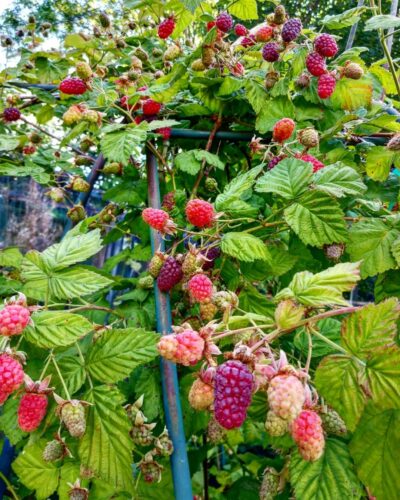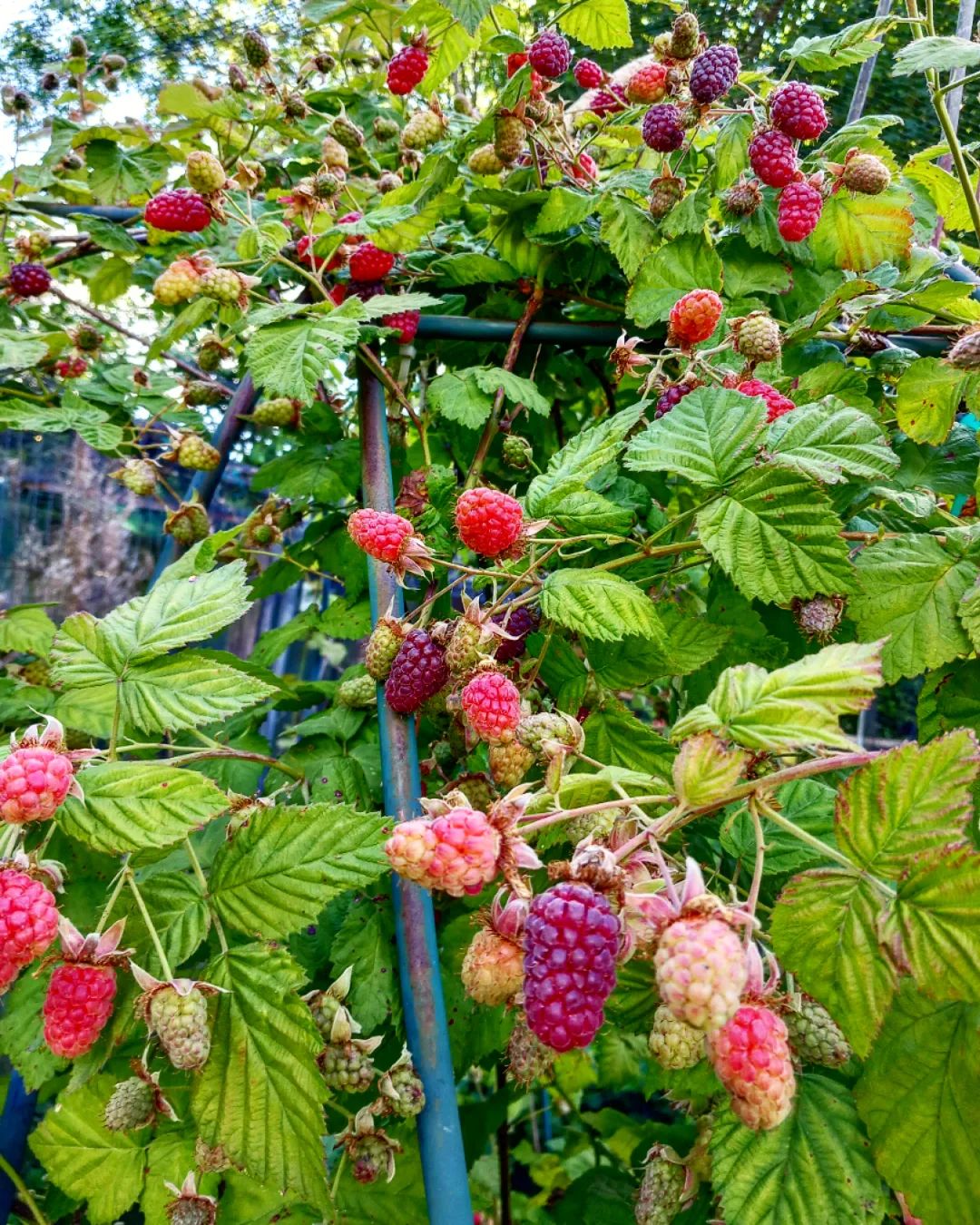Learn how to grow and care for for loganberries with the help of this easy guide and harvest delicious, sweet fruits.
Loganberries ((Rubus x loganobaccus) are named after James Harvey Logan, who loved growing raspberries and blackberries. In the 1880s, he found this natural mix of the two growing in his garden in California and named it after himself. The berries look more like raspberries, but the plants grow and spread like blackberry bushes. You can hardly find loganberries in shops because they are difficult to harvest and don’t stay fresh for long. This makes loganberries a great choice to grow in your garden or landscape. They produce fruit in July and August, which fills the gap between strawberries and summer raspberries, and then fall raspberries and blackberries.
These berries are a cross between blackberries and raspberries. They offer big, cone-shaped, dark red berries that are very juicy and tart and rich. You can eat them fresh, but they are often used to make jam, desserts like summer pudding, pies, and fruit sauces.
They are like tayberries because both are a mix of raspberries and blackberries. Loganberries also ripen about three weeks earlier than tayberries. These berries are darker and taste sharper, while tayberries are more red and sweeter.
Loganberries are thorny plants that need a lot of room, but there’s a smaller, thornless variety you can grow. They self-pollinate, so one plant is enough to give you plenty of fruit—perfect for most gardens. Loganberries are very hardy and can produce good fruit for at least 10 years.
How to Plant Loganberries

Loganberries are most common in Washington and Oregon because of their growing needs. The plants don’t handle drought or cold well, so they can be hard to grow in many places. The Pacific Northwest has the perfect climate for them. If you’re in the right climate, taking care of loganberries is pretty simple.
Loganberries are usually planted as bare-root plants between November and March. You can order them online or by mail from specialist fruit sellers. In spring and summer, you might also find potted loganberry plants at garden centers.
Before planting, set up supports for the plants, like wires along a wall or fence or a strong wooden post with wires. One plant is usually enough for a small garden, but if you’re planting more, leave at least 2 meters of space between each plant.
Grow a potted loganberry in spring or summer in the same way. Remember to add lots of compost to the soil.
Plant bare-root loganberries as soon as they arrive unless the ground is frozen. Soak the roots in water for a couple of hours before planting. Dig a large hole about twice the size of the roots, and add compost or well-rotted manure to the bottom. Place the plant in the hole at the same depth it was previously planted (you’ll see a mark on the stem). Fill the hole back in, press the soil down firmly, and water well.
Loganberries usually mature in a year or two. Water them well during their first growing season, especially in dry weather.
Propagating Loganberries
The best way to grow new loganberry plants is by layering or using hardwood cuttings. The easiest method, though, is to let the plant grow a new one naturally. If a stem tip touches the ground, it will quickly grow roots and new shoots. Your plant might do this on its own, or you can pin a stem tip to the ground and wait for it to root. Once it does, you can dig it up and plant it elsewhere.
Loganberry Varieties
Loganberry LY654: This compact, thornless cultivar offers long, conical, sweet fruits. HxS: 1.5m x 2m
Loganberry LY59: It is an original loganberry variety. This variety produces thorny stems.
Ideal Growing Conditions for Loganberries
Light
Choose a sunny site for growing loganberries. They can tolerate partial shade, but that can impact fruiting.
Soil
Loganberries grow best in well-drained soil that is rich in organic matter. If your soil is heavy or clay-like, mix in compost or well-rotted manure to help with drainage and make it more fertile.
Water
Loganberries need regular watering, especially when they’re producing fruit. Keep the soil evenly moist but not too wet.
Loganberries Care
Fertilizer
Each spring, add well-rotted compost or manure around the Loganberry plant. Sprinkle some potash and blood and bone meal too. If the leaves look unhealthy, use an organic liquid fertilizer during the growing season.
Support
Loganberries stems trail long, so they need a sturdy support or trellis to keep them off the ground.
Mulching
In spring, spread well-rotted manure or garden compost around your plants. During summer, you might want to protect the fruits from birds.
Pruning and Training
Prune loganberries in late summer or autumn after they finish fruiting. Cut the old canes that have already fruited down to the base. Leave the new pale green canes, as they will produce fruit next year. Tie the new canes to their supports.
You can gather all the new stems from that year into a bundle and tie them to the top wire. After the plant has finished fruiting, cut the old stems down to the ground. Then, untie the bundle of new stems and spread them out to one side of the main stem.
Loganberries are often grown in a fan shape against a wall or fence or tied to a wooden post and wire system. To make a post and wire system, set up sturdy 2-meter wooden posts at each end of your row and stretch wires between them. Tie the canes to the wires as they grow. You can add a wooden T-piece to the top of each post to hold bird netting if needed.
Problems
If birds are eating the fruits, cover the plants with netting in summer. Make sure the netting is safe so that hedgehogs, small animals, or birds don’t get trapped in it.
Harvesting and Storage
Loganberries are ready to pick when they are deep red or almost purple. The fruit should come off its white core with a gentle pull. Be careful when picking, as the berries are delicate and can crush easily.
It’s best to pick and eat loganberries on the same day. If you need to store them, keep unwashed berries in a single layer in the fridge for a few days (washing adds moisture, which can cause mold). Loganberries also freeze well—spread them out on a tray to freeze, then transfer to a box or bag for up to two months.


